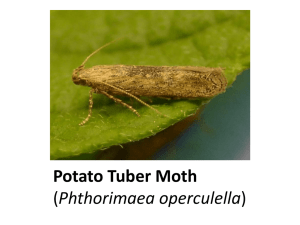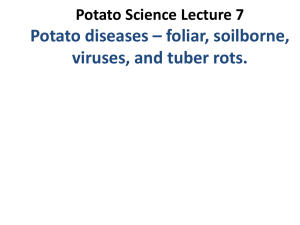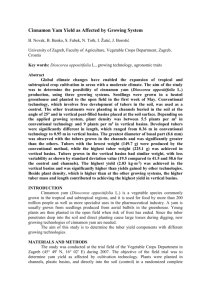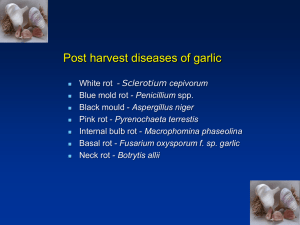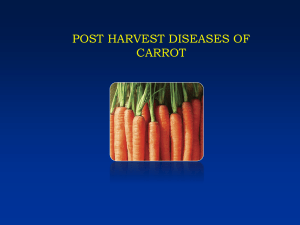Potato
advertisement
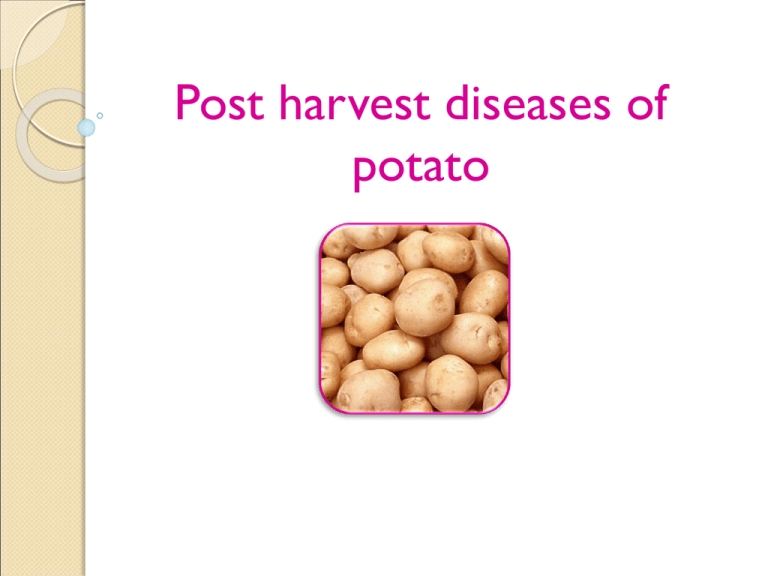
Post harvest diseases of potato List of diseases Black Leg - Erwinia carotovora Dry rot - Fusarium coeruleum Brown rot - Ralstonia solanacearum Potato wart - Synchytrium endobioticum Late blight - Phytophthora infestans Scab - Streptomyces Scabies Sclerotium rot - Sclerotium rolfsii Silver scurf - Spondyocladium atrovirens Charcoal rot - Macrophomina phaseolina Black leg - Erwinia spp Aerial stem rot & tuber soft rot Black leg begins from a contaminated seed piece Stem bases - an inky-black to light-brown decay, extend up the stem from less than an inch to more than two feet These enlarge into a soft, mushy rot that causes entire stems to wilt and die Leaves - roll upward at the margins, become yellow, wilt & often die Potato tubers with soft rot have tissues ◦ very soft and watery ◦ have a slightly granular consistency ◦ tissue is cream to tan-colored ◦ black border separating diseased from healthy areas In the early stages, soft-rot decay - odorless Later a foul odor and a stringy or slimy decay usually develops as secondary decay bacteria invade infected tissues Symptoms of black leg Survival and spread Blackleg - Erwinia carotovora subsp. atroseptica Carried by contaminated seed tubers Usually dormant and do not cause disease unless environmental conditions are favorable Aerial stem rot - Erwinia carotovora subsp. Carotovora Contained in infested soil or introduced to the crop by irrigation water, wind-blown rain, and insects Tuber soft rot - caused by either of these soft-rot bacteria Maggot flies (Hylemyia spp. and Phorlin spp.) - spread the black leg and soft rot Epidemiology High soil temperatures and bruising of seed tubers favor seed-piece decay RH - 94 to 100% & temp - 21 to 29oC Management Plant only certified, disease-free seed tubers Seed treatment ◦ Agallol-3(0.25%) for 5 min ◦ Streptomycin sulphate 0.1 % for 10 min ◦ Streptocycline ( 100 ppm) and copper sulphate ( 40 ppm) for 30 min Harvest tubers only after the vines are completely dead to ensure skin maturity Precautions to minimize cuts and bruises when harvesting and handling tubers Storage - 55-60 F with 90-95% relative humidity for the first 1-2 weeks to promote wound healing Dry rot F. solani var. coeruleum Dry dark spots appear on the skin which later becomes sunken and wrinkled with irregular concentric rings Spots shrinks and bursts out Internal tissue becomes brown and shrunken with cavities filled with numerous white tufts of mycelium Rotting progress into whole tuber which loses much of water and become dry hard, shriveled and light in weight Fungus Mycelium – branched, septate Hyphae break through the skin and form pustules on the surface Pustule – closely interwoven hyphae which give rise to branched conidiophores bearing conidia Mode of spread and survival Contaminated soil - chief source Mycelium, conidia and chlamydospores - present in the soil Conidia floating in the air or found on the floor and walls of stores infect injured tubers Epidemiology Temp -15 to 25oC RH - 50% Management Avoid injuries to tubers Potatoes should be dried thoroughly and then stored in a cool place To speed the healing process, hold tubers at 50° to 60°F with good ventilation and a RH of at least 95% for the first 2 to 3 weeks of storage Brown rot Ralstonia solanacearum Bangle blight or bangili Leaf- turns bronze colour, shrivel and die Vascular system of stem, root, stolon and tuber turns brown Ring disease - brown ring in the tuber due to discolouration of vascular bundles Whitish bacterial exudate oozes from the vascular system of cut stems and cut tubers Casual organism Gram –ve, rod shaped bacteria, polar flagellum Forms no spores and capsules Mode of spread and survival Infected soil and seed tubers - source of infection Decay plant parts release masses of bacteria in the soil - viable from season to season Infection through wounds in roots which spread through vascular system into the stem Epidemiology Soil temp - 25 to 35oC Moisture - 50 % Optimum pH - 6.2 to 6.6 Management Crop rotation - potato-wheat High degree of resistance - clones of Solanum phureja Late blight Phytophthora infestans Irish famine - 1845-46 Symptoms Leaves, stems and tubers Water soaked spots appear on leaves, turn purple brown & finally black colour White growth develops on under surface Stem breaks at these points and the plant topples In tubers - purplish brown spots & spread to entire surface Tuber show rusty brown necrosis spreading from surface to the center Fungus Mycelium - endophytic, coenocytic and hyaline Sporangiophores – arise from internal mycelium through stomata on the tubers Sporangia - multinucleate, thin walled, hyaline, oval shaped Zoospores - biflagellate Phytophthora infestans A, zoospores produced within the lemon-shaped sporangia (B). Mode of spread and survival Infected tubers and infected soil - source of primary infection Survival of fungus in fruiting stage or as dormant mycelium in the soil Persisting of perennial mycelium in affected tubers from the field, stored and used as seed in next season Epidemiology Cool (12 to 15oC) and humid ( above 90 %) weather with rains alternating with warm (20o C) moist period Control S. demissum and S. phureja - used for breeding for disease resistant varieties Varieties - Kufri Naveen, Kufri Jeevan, Kufri Alenkar, Kufri Moti Bruising of tubers at harvest should be avoided Regular spraying during growing season gives effective control- 10 to 15 days interval ◦ Brestan 600g/ha ◦ Zineb 0.2 % ◦ Bordeaux mixture 1.0% ◦ Mancozeb (2 kg/ha) Scab Streptomyces scabies Shallow scab – corky tissue which arises from abnormal proliferation of the cells of the periderm of the tuber Lesions vary in size and shape and darker than the healthy skin Corky lesions 1 to 3mm deep and darker than shallow lesions Actinomycete attacks young tubers at a early stage of development Actinomycete Conidia – produced by formation of septa, which contract to form narrow isthmuses between the cells Conidia- cylindrical and hyaline Mode of spread and survival Affects cabbage, carrot, eggplant, onion, radish Contaminated soil and infected tubers - source of infection Pathogen may survive passage through digestive tract of animals and hence it may spread with farm yard manure Control measures Use disease free planting materials Soil application of PCNB (30kg/ha) at the time of planting Green manuring before planting – effectively reduce disease incidence Seed treatment - mercuric chloride 0.1 % High degree of resistance - S. caldasii var. glabrescens, S. chacoense & S. commersonii Varieties - Menominee, Russet Rural, Sebago Potato wart Synchytrium endobioticum Warts As small white granular swellings on the eyes Remain minute or may become as large as the tuber Soft, pulpy, white to begin & become black later Fungus Do not develop any mycelium Produce summer sporangia – thin walled Sporangia release zoospores which attack the tubers Live resting (winter) sporangium of S. endobioticum. Mode of survival and spread Resting spores - viable in soil for 20-25 yrs Withstand passage through the intestines of cattle Spread - contaminated manure, soil, infected seed tubers Epidemiology Temp - 16.7 to 17.8oc Presence of oxygen and nitrates in soil favours the germination of sporangia Management Resistant cultivars - Kufri Kanchar, Kufri Sherpa, Kufri Jyoti Steam sterilization of soil Soil treatment – mercuric chloride and formalin 5% Sclerotium rot Sclerotium rolfsii Thick white strands of fungus appear at the collar region of the stem and roots White fungal hyphae grow on the tubers which later start rotting and covered by fruiting bodies Fungus Silky white mycelium Septate and branched hyphae Globose, smooth surfaced sclerotia Mode of survival - mycelium and sclerotia subsists in soil Mode of spread - infected soil, in running water & on farm implements Epidemiology Temp - 30-35oc Thrives in sandy or loamy soil which are acidic Alternate wet & dry soil conditions favour the disease development Management Application of ammonium nitrate to the soil Seed tuber treatment - PCNB@ 15 kg/ha Resistant clones - S. acaule, S. multiinerruptum, S. infundibuliformae Resistant varieties - Kufri Bahar, Kufri Jyoti, Kufri Muthu, Kufri Sherpa Charcoal rot Macrophomina phaseolina Black spot (2-3mm in dia) develops around the lenticels which appears as whitish specks at the centre On cutting - internal tissues shows black patches beneath the spots on the surface of the tuber Fungus Mycelium - sparse or fluffy Hyphae - branched, septate and greyish white or brown Sclerotia - minute, black and smooth Conidiophores - simple and rod shaped Conidia - one celled, hyaline, oval or elliptical Mode of spread and survival Pathogen present in the soil - primary source of inoculum Entry of fungus - bruising of skin, insect damage Sclerotia – survive in the soil for more than 3 yrs Epidemiology Disease is more severe in wet soil Temp - 31oc Management Avoid bruising of tubers during harvest, collection and storage Temp of store house should be low Early maturing varieties - Kufri Chandramukhi, Kufri Alankar Silver scurf Spondyocladium atrovirens Lesions - brown, slightly depressed and circular with fimbriate margins Dotted with minute black specks or sclerotia of the pathogen Organism invades only the cork cells which are destroyed and slough off forming a ‘scurf’ Fungus Hyphae – septate, branched, hyaline and become brown with age Conidia- dark brown, club shaped, thick walled Hyphae form minute sclerotia Pathogen live from season to season on the affected tubers and in the soil Spread from diseased to healthy tubers in storage Management Use of disease free seed material Seed treatment- mercuric chloride - 0.1% for 30 min
